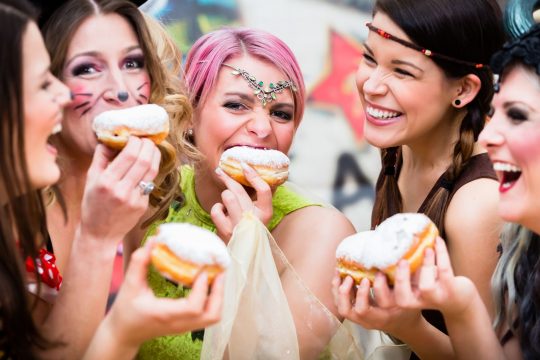This article may contain affiliate links. We may receive a commission for purchases made through these links. Privacy Policy.
You’d have to go pretty far to find a holiday that’s more OTT than Mardi Gras. The mere words conjure up images of fantastical parades, feather-covered dancers shaking their moneymakers and rowdy onlookers who occasionally disrobe in exchange for a few plastic beads. All of it accompanied by plenty of music and alcohol, of course.
Yep, it’s a whole lot of hoopla. And while many of us dream of making it to Louisiana to join in on the oh-so-extra festivities, not all of us know why one of the biggest parties in the US and beyond got started.
To give you a more informed outlook on all of this debauchery, we’re going to serve up some Mardi Gras history that explains how this major throw-down of a festival got started. And we’ll also fill you in some of the best places to join in on the fun and continue this colorful tradition.
Without further ado, let’s get this party started, y’all!
Mardi Gras – The Storm Before the Quiet
Mardi Gras literally means Fat Tuesday in French. So what does that have to do with anything?
Well, if you even have a vague idea of what this Christian holiday is about, you know that Mardi Gras is always celebrated one day before Ash Wednesday and the beginning of Lent. Because Lent is supposed to be a more thoughtful time of fasting and prayer that leads up to Easter, Christians started using Mardi Gras as a time to indulge in the good life before having to buckle up for 40 days of self-discipline.
In France, it was called Fat Tuesday because revelers would binge on fatty foods like meat and lard before cutting back to a diet of fish or even periods of fasting. (Though we’re guessing they still ate carbs.)
Mardi Gras – One Big Carnival

Here in the states, we may know this raucous festival as Mardi Gras, but through much of the world, it’s known as Carnival. And it’s not limited to just one day. The Carnival season actually starts the day after Three King’s Day on January 6th and continues all the way through Fat Tuesday.
Interesting fact: the medieval roots of Carnival come from the Latin “carne vale,” which means “flesh, farewell.” Who knew giving up meat for 40 days could lead to so much fun?
Pagans vs. Christians
According to a certain historical perspective, if you scratch the surface of a Christian holiday, you’ll find some pagan rites lurking behind it. One theory about the roots of Carnival is that it’s linked to an ancient Pagan celebration in Rome called Lupercalia.
To give you a brief snapshot of what that was all about, think bloody sacrifices, sex with strangers and a whole lot of binge drinking. In the “If You Can’t Beat ‘Em Join ‘Em” school of thought, the Catholic Church absorbed a more sanitized version of the festival because it was easier than eradicating it altogether.
However, some scholars actually believe that Carnival popped up all on its own because the church frowned on both meat-eating and sex during the 40 days of Lent. It’s even been theorized that the Catholic Church spread the rumors about the festival’s Pagan roots to curtail all the rampant overindulgence that’s associated with Carnival. If that is the case, they’re planned woefully backfired.
The First American Mardi Gras
In 1699 French-Canadian explorer Pierre Le Moyne d’iberville set up camp about 60 miles from New Orleans in what is now Mobile, Alabama. Because it was Fat Tuesday, he dubbed the spot Point Du Mardi Gras and held a small celebration.
So while New Orleans is synonymous with Mardi Gras, it’s Mobile that has claim to the first Mardis Gras celebration. However, the festivities soon got rolling in the Big Easy when Jean Baptiste Le Moyne Sieur de Bienville founded New Orleans in 1718. In the decades that followed, Mardi Gras grew into an annual affair featuring masked balls and other festivities.
Spanish Conquistadors – Say Hola to the Fun Police
Yes, it was all fun, games and parties until the Spanish Conquistadores started ruling the region around 1762. They’re said to have squelched the festivities until the end of their rule around 1800. Then the US authorities took over as the official buzz killers and actually instituted a law against masked balls and wearing costumes in public.
But because it’s hard to keep a good time down, officials eventually accepted the celebration and the very first street Mardi Gras parade was held in New Orleans in 1838.
Related: The History of Valentine’s Day [A Bloody Origin Story]
The Carnival Krewes – Party Saviors
Although the crackdown on Mardi Gras eased up for a few years, by 1857 the parades had become so drunken and out of control that officials were threatening to ban them altogether. That’s when a group that came to be known as the Mistick Krewe of Comus formed a secret society.
In addition to holding their own private Mardi Gras ball, they also staged a more civilized parade as an alternative to all the craziness.
Not only did they save the festival, but they also inspired the formation of a variety of other krewes with their own balls, suppers and parades. Today, it’s said that there are over 70 Krewes operating in New Orleans alone.
For the pet lover, Ravi Parikh with RoverPass recommends checking out the Mystic Krewe of Barkus. “This is the official Mardi Gras krewe for canines, and the pup parade never disappoints! It follows a 15-block route through the French Quarter and stops at Good Friends Bar along the way. It is not to be missed!”
All we have to say is thank goodness for party planning.
King of the Krewes
One of the most famous Krewes in New Orleans is known as the Krewe of Rex, which means “king” in Latin. Founded in 1872, their first parade got off to a bang when the Grand Duke Alexis Romanov Alexandrovitch accepted their invitation to attend the festivities and was dubbed King of Carnival.
(Since his brother was the heir to the Russian throne, one can only wonder how much the Duke basked in the elevated rank of his parade title.)
Ever since then, the Krewe of Rex has continued the tradition by picking a prominent person to hold the title of King. As a lucky strike extra, the “Rex” is also given a key to the city by the Mayor. Nice job if you can get it.
Bead Throwing – The Pre-Bearing-Your-Breasts Era
The Krewe of Rex is also linked to the traditional colors of Mardi Gras. When the Duke of Russia visited, the club chose the colors of his royal house for the beads they would be throwing from their floats. (Though the original krewe to start the custom of “throws” was the Twelfth Night Revelers in 1870.)
These colors were also assigned meaning. Purple stood for justice, green for faith and gold for power. The beads were supposed to be tossed to onlookers who were thought to possess these traits and were also considered good luck.
Strange to think that people are exhibiting many things beyond good character to get those beads today.
King of the Cakes – Caution: Choking Hazard
One of the most popular foods eaten during the Carnival season is known as King cake. This sweet treat dates all the way back to the Middle Ages when people began to celebrate Three Kings Day – the day the wise men gave gifts to the baby Jesus.
One of the current mardi gras traditions is to give children presents and eat a special cake on January 6th – a custom that lives on to this day. In recent times, these cakes are often made of Danish pastry and frosted with the traditional colors of purple, green and gold.
Beginning in the 1940s, a small figurine of the baby Jesus was baked into these cakes. According to custom, if you find the figurine in your piece of cake, you have to host the next party. Fun as that sounds, many bakeries have chosen to serve up the baby Jesus on the side these days to avoid choking accidents and lawsuits.
Caution: Hide the king of kings at your own risk.
Related: The History of Groundhog Day (From Pagan Rituals to Rom-Coms)
The Best Places to Celebrate Mardi Gras (In the USA and Beyond)

If all of this talk about parades, drinking and over-the-top revelry makes you want to get your party on, there are plenty of places to do it. Here are a few of our favorite picks.
1. New Orleans
No list would be complete without the Big Easy. Though Mardi Gras was canceled last year due to the pandemic, the party is back on schedule in 2022. One of the most famous celebrations in the US and the world, the city of New Orleans is on a lot of people’s bucket lists for good reason.
But if you’re looking for alternatives, read on….
2. St. Louis, Missouri
Never associated the midwest with Mardi Gras? In that case, you should know that St. Louis hosts the next biggest Mardi Gras celebration in the US after New Orleans. Most of the events take place in the historic Soulard neighborhood, but you’ll also find parades and balls throughout other parts of the city.
Be sure to check out the winter carnival, dog parade, cajun cookoff and the Bud Light Grand Parade.
Of course, you may want to consult the weather report before you don your masks, as cold can be an issue when partying in this town. But you can always warm up with some jambalaya and other New Orlena-style style cuisine that the city prides itself on.
3. Mobile, Alabama
It may not be as big and rowdy as New Orleans, but Mobile, Alabama lays claim to the oldest Mardi Gras celebration in the US.
Two weeks before Fat Tuesday, the city explodes with parades, dancers and all sorts of other entertainment. You may also want to check out the Mobile Carnival Museum to learn some history and go on a self-guided tour of the lavishly decorated homes.
4. Galveston, Texas
Want to celebrate Mardi Gras and head to the beach? Then you may want to party in the seaside town of Galveston. Home to the third-largest celebration in the US, you’ll find tons of live concerts, parades, balcony parties, elegant balls and, of course, plenty to drink.
Yep, they do it up big in Texas!
5. San Diego, California
Live closer to the left coast? Then don’t count California out when it comes to Mardi Gras. San Diego’s Gaslamp district holds a huge 1-day block party and masquerade parade featuring the requisite OTT floats, feathered dancers and much more.
You’ll also find plenty of music and great bars and restaurants – not to mention that hipster so-cal vibe and beautiful beaches.
6. Rio De Janeiro, Brazil
By far the biggest Carnival celebration in the world, Rio attracts about 500,000 visitors a year. If you want your celebration extra extra, this is the place to go. Famed for their flamboyantly clad samba dancers, the event is an explosion of dancing, outrageous floats, non-stop music, food and general raucousness.
A definite candidate for your bucket list!
7. Venice, Italy
Europe has quite a Mardis Gras history as well. The first Carnival celebration in Venice dates all the way back to 1162, making it one of the oldest in the world. And the two-week celebration is nothing short of spectacular. Famed for revelers clad in elaborate masks and historical costumes, the event has a magical atmosphere and includes parades, masked balls and costume competitions.
You may want to join in the Mardis Gras festivities here before the city sinks!
8. Nice, France
In addition to mild weather and beautiful coastline, Nice has plenty to offer when it comes to celebrating Carnival. One of the most unique features is their flower parades, in which fantastically clad models throw blossoms to the onlookers from their floats.
You’ll also want to see the Carnival Parade of Lights. Held in the evening at Place Masséna, the colorful light show sheds a magical glow on the lavish floats.
And the Party Rolls on….
Mardi Gras has had its ups, downs and occasional cancellations since it first started back in 1699, but this flamboyant festival is living proof that it’s hard to keep party people down. And though it’s traditionally a Christian celebration, people from all walks of life are welcome to join in on the fun during Mardis Gras season.
So whether you plan to cut back on meat and other indulgences during Lent or not, you may want to get out there and shake your tail feathers with the rest of the revelers. There’s no time like the present to celebrate life no matter what your reasons may be.
Have fun, y’all!
You might also be interested in: The History Of Daylight Savings Time [Why Do We Adjust Our Clocks?]







